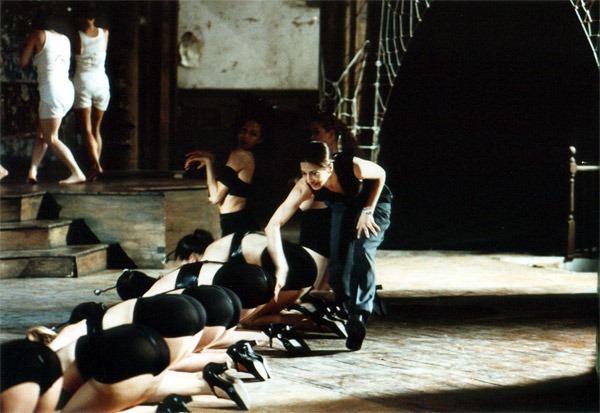
The View From the Top
Written by Ellen Mills | Posted by: Anonymous
When friends go to film festivals together, they get ideas. Laura Teodosio and Jennie Livingston have been friends for years and went together to the Sundance Film Festival in 2004. At the time, Livingston, whose first film, "Paris is Burning" was a critical and commercial success, was having trouble finding funding for her feature project titled, "Who’s The Top," despite the fact that she had cast and shot a trailer which had generated interest, but no investors. The two friends attended one of the short film screenings and afterward, Teodosio had the first idea: film "Top" as a short instead of a feature. Livingston resisted, and then she got the second idea: Teodosio should produce it.
Teodosio was new to film producing, but not new to media. She is the founder, president and CTO of Salient Stills, a Boston company which develops digital imaging products to produce still images from video and photographic sources. She has a M.S. in Media Arts and Sciences from the MIT Media Lab, and in her own words, "I’ve always been interested in where software and media intersect."
Livingston wrote the script for "Who’s The Top" in 1994. She has said that her pitch was, "Woody Allen’s younger dyke sister goes to the s/m dungeon… with musical numbers." Teodosio read the script and liked it, especially the main character who is a smart, sensual female and "a character not well represented in the media," she says. She encouraged her friend to produce the film, even helped with some early fundraising, but was busy with her own career and didn’t envision being involved in the production.
Initially, Livingston worked with veteran producer Ruth Charny ("Grace of My Heart" and "Love Liza") and in 1999 they shot and edited a "teaser" trailer to give potential investors an idea of the film and to show that Livingston could direct a narrative. Producing the trailer was no small endeavor. It involved casting for the main roles, but also needed a troupe of dancers and a choreographer to execute the dance numbers which are integral to the story. Despite good "buzz" and interest, they found no funding. Then Livingston suffered a devastating personal loss when her brother died, and she was not able to devote time or passion to the project. A few years later, Charny chose to concentrate her energies on family and other professional interests. As Livingston describes it, "By the time Laura suggested I make "Who’s The Top" into a short, I felt that the project was simply halted."
Livingston says Teodosio "brought passion to the project, and energy and an entrepreneurial spirit — that is what she is, after all, an entrepreneur and an inventor."
"It was encouraging, above all, that Laura thought that the story was worth telling," Livingston says. "Any independent producer trying to produce a difficult-to-produce film like ours needs to, at the core, feel the story has merit: that’s what gets you through the difficult times of trying to find money, find help, and get the project seen."
When Teodosio came on board as producer, most of the footage was shot, but she says, "We needed to find out how to turn the trailer into a movie." Together they worked on the narrative, figured out how to end it and planned the interstitial scenes. It was clear that they needed to do some more shooting, but five years had passed since the initial shoot and it was uncertain if the actors would be willing to do it.
The lead actor, Marin Hinkle, had moved to Los Angeles, gotten roles in two television shows ("Once and Again" and "Two and a Half Men") and had a baby. Hinkle, who grew up in Newton, MA, wanted to see it completed and she agreed to fly to New York for one day of shooting. "It was one long day of shooting," Teodosio remembers. "Marin flew in at 5 am and she went back to L.A. on the very last plane." Livingston then flew to Los Angeles twice to work with Hinkle on the narration.
In the film, Hinkle plays Alixe, a lesbian poet who lives with her lover Gwen ( Brigitte Bako). Some tension has developed between them over Alixe’s admiration for another poet/adventurer named CYMON Blank (Steve Buscemi) and her growing interest in having a kinkier sex life. Gwen is cool to both of Alixe’s interests and complications occur when Alixe goes to San Francisco to interview CYMON and happens to meet Buzz and Mars, two old acquaintances who are open minded about sexual practices.
The musical numbers illustrate Alixe’s inner dialogue and her exploration of her desires. They are an integral part of the story and one of the key reasons that Livingston felt she had to shoot footage in order to show investors. As Teodosio explains, "In the script it said: ‘dance number: leather girls vs. vanilla girls.’ You read that and it’s unclear what you’re going to do."
The process was "intense" for Teodosio. "I have a significant full-time job," says the Boston based business owner. "I spent three weekends out of four in Brooklyn over the last year. And when not in NYC, nearly all my evenings from pre-production through festival distribution have been filled with film work."
How was it for the friends to work together? Ultimately rewarding, but not without its tensions and compromises along the way they both say. Livingston says, "I think you have to be a saint to do this work and not have some big tensions; but saints wisely know to stay out of the film business."
"Jenny knows what she wants visually and from the actors and she is good at getting that on the set," Teodosio says. "She has high standards, most especially from herself. The talented people around her rise to that level of expectation, the result of which you can see on screen."
The film was shot on super 16, but they used 35mm for the dance numbers. "The costumes are incredibly detailed and we wanted that detail to be seen," Teodosio explains. Livingston had the footage digitized and then edited the short herself using Final Cut Pro. She would send tapes to Teodosio and then on weekends, they would review the cuts together. "We’d invite folks over for screenings and we’d tweak it." Original producer Ruth Charny was a regular viewer. "She is very talented and generous with her time," Teodosio said. "She came to many screenings and shared her insightful ideas."
Teodosio and Livingston applied to festivals and were accepted into several including the Berlin Film Festival. Teodosio says it was a challenge to get the final cut done and the print struck by the deadline. In fact, a friend hand carried the print to Berlin for them. It screened five times in Berlin and was well received despite the producer’s concern that its extensive voice-over narration in English might hinder its popularity.
Teodosio says that the festival response to the film has been excellent, noting that it has played to many different kinds of audiences. "We had a wonderful response at the MFA [in Boston]. It was almost full. They have a beautiful theatre with great sound. The audience was quite enthusiastic and very engaged."
Gay and lesbian audiences have been particularly receptive to the film and its lesbian protagonist. It screened with "Paris Is Burning" at the gay and lesbian film festivals in San Francisco and Los Angeles. At the Philadelphia International Gay and Lesbian Film Festival it won "Best Lesbian Short."
Teodosio feels that all audiences respond to the themes of love and partnership and power in the film as well as "how intellect and libido may oppose each other."
While the visibility of gays and lesbians in television has increased thanks to shows like "Queer as Folk" and "The L Word," Teodosio and Livingston both feel that there’s plenty of room in films for more female characters who are intelligent, and sensual and looking for love and what they are meant to do in their life.
Teodosio sees many similarities between her first career starting a software company and her second career as the producer of an independent film. "The core of the project is a passionate idea, whether it be a story or a product, and a small set of folks who want nothing more than to create and share that experience with the world," she says. "…the skills of fundraising, pitching, attempting to do a lot more than you have money for, managing a team of talented creative folks who are often working for less than they should be, making hard creative decisions because you need to stay in budget and on schedule …marketing, promoting and ultimately selling a result."
The two friends are still getting ideas, this time they are about making "Who’s The Top" into a feature film. "Times are different than 1999 when Jennie and Ruth first tried to raise money for this film," Teodosio says. "Gay characters have become more prevalent in mass media and dance and musicals [like "Moulin Rouge"] have proven they can make money.
"There is a script and a budget and now a DVD that shows how the very complex ideas in the script could turn into an equally rich, visually stunning and ultimately moving film," she says, sounding like she has plans to see her name in the credits at least once more.
For more information about 'Who's the Top' visit www.whosthetop.org.









